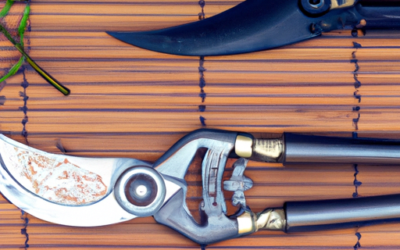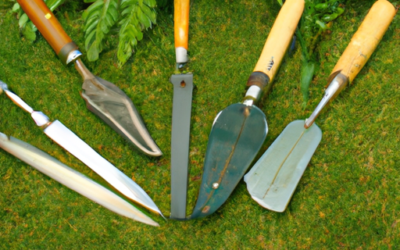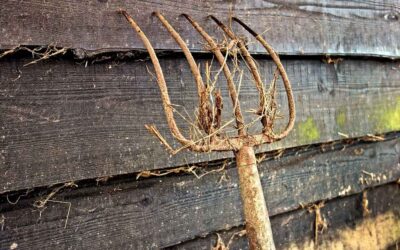If you’re a gardening enthusiast seeking an efficient tool for intricate pruning and grafting tasks, the Kiridashi knife might be your new best friend. This comprehensive buying guide will equip you with the crucial knowledge needed to make an informed purchase tailored to your gardening needs. Imagine being armed and ready to tackle your garden’s most delicate tasks with this quintessential Japanese tool, enhancing both your experience and your garden’s aesthetic.
Understanding the Use of Kiridashi Knife in Gardening
As a gardening enthusiast, you may have come across different types of tools that have piqued your interest. One such tool is the Kiridashi knife. This guide is designed to help you understand the uses and benefits of this versatile tool in gardening.
Historical Origin of Kiridashi Knives
Originating from Japan, the Kiridashi knife has a rich history that dates back centuries. It was initially used for various purposes like crafting, woodwork, and even in leather industry. Over the years, gardeners began to see the value in this simple yet efficient tool. Its sharpness, ease of use, and durability make it an ideal choice for gardening tasks.
Gardening Tasks Suitable for Kiridashi Knives
Kiridashi knives are incredibly versatile and can be used for numerous tasks in the garden. You can use them for precision pruning, harvesting fruits and vegetables, slicing through roots, and even for grafting plants. Due to their sharp, pointed tip, Kiridashi knives are perfect for jobs that require intricate detail and precision.
Types of Kiridashi Knives for Gardeners
Just like any other tool, Kiridashi knives come in different types, each designed to suit your specific gardening needs.
The Single Bevel Kiridashi
The single bevel Kiridashi knife has one side of the blade angled, while the other side remains flat. This design allows for precise cutting, making it a favorite among gardeners who require precision in their tasks.
The Double Bevel Kiridashi
A double bevel Kiridashi knife, on the other hand, has both sides of the blade angled. This style is less precise than its single-bevel counterpart, but it is more versatile and can be used for a wider range of tasks within the garden.
Variations in Blade Lengths
Kiridashi knives come in a variety of blade lengths to suit different tasks and personal preferences. Shorter blades are ideal for intricate tasks like pruning small plants, while longer blades are perfect for tasks that require a bit more force, like cutting through roots.
Variations in Blade Shapes
On top of differing lengths, Kiridashi knives also come in various blade shapes, including straight, curved, and angled. Each shape suits different types of gardening tasks, with straight blades being the most versatile.
Materials and Durability of Kiridashi Knives
Understanding the materials used to make Kiridashi knives and their resulting durability is essential when choosing the right one for your needs.
Common Material Options
Kiridashi knives are traditionally made from high-carbon steel, which is renowned for its sharpness and longevity. However, you can also find models made from stainless steel, which offers superior corrosion resistance, albeit at a bit of a cost to sharpness.
Understanding Tempering and Hardness
During the manufacturing process, Kiridashi knives undergo a process known as tempering. This process heats the blade to a specific temperature before rapidly cooling it, resulting in a hardened blade that can maintain its sharpness for a longer time.
Corrosion Resistance and Maintenance
Given that they are frequently exposed to moisture and plant saps, Kiridashi knives need to be corrosion-resistant. High-carbon steel knives, though excellent in terms of sharpness, require regular maintenance to prevent rusting. However, if this seems like too much work, you might want to consider stainless steel options.
Ergonomics and User Comfort
When choosing a Kiridashi knife, it’s important to consider how comfortable it is to use.
Handle Design Relevance
A poorly designed handle can result in fatigue and even injuries. Look for Kiridashi knives with ergonomic handles that fit comfortably in your hand, preferably made of non-slip materials.
Weight and Balance of the Knife
The weight and balance of the knife also play a role in your comfort. A good Kiridashi knife should be light enough to handle easily, yet balanced enough to provide control during use.
Ease of Handling and Safety Features
A sharp blade isn’t the only important feature of a good Kiridashi knife, the ease of handling and safety features are also crucial. Look for knives with features like blade guards and locks to ensure safe use.
Knife Blade Features
Understanding the features of the Kiridashi knife blade can help you make a smart choice.
Understanding the Blade Edge
Kiridashi knife edges can be either straight or curved. While straight edges provide precise cuts, curved ones offer versatility and ease, especially when dealing with plants or objects of different shapes and sizes.
Importance of Blade Tip
The Kiridashi knife’s role doesn’t just stop at slicing; the pointed tip is perfect for detail work such as removing leaf buds or creating starter holes for seeds.
Sharpness Retention Ability
A good Kiridashi knife should maintain its edge for a long time. High-carbon steel knives are known for their sharpness retention, but they require regular sharpening to keep them at their best.
Price and Value
When shopping for a Kiridashi knife, it’s important to get one that delivers value for money.
Factors Affecting Price of Kiridashi Knives
The price of a Kiridashi knife is influenced by factors such as the materials used, the brand, the blade’s features, and the location of manufacture. Typically, high-quality, high-carbon steel knives from well-known brands will be more expensive than their more simply designed, less-known counterparts.
Balancing Cost Versus Quality
Quality should always be a priority when choosing a Kiridashi knife. While it may be tempting to go for the cheapest option, remember that you often get what you pay for. A high-quality knife may cost more initially, but it will also last longer and perform better, saving you money in the long run.
Long-Term Value Considerations
When purchasing a Kiridashi knife, you should consider the long-term value the knife can bring you. Consider its durability, versatility, and ease of maintenance. Will it give you years of reliable service? Is it easy to care for? Will it suit various tasks in your garden? Answering these questions will help you decide whether a particular knife is a worthwhile investment.
Selecting the Right Size of Kiridashi Knife
Choosing the right size of Kiridashi knife is crucial for effortless and effective use.
Choosing Based on The Kind of Gardening Work Intended
The nature of your gardening work will determine the size of the Kiridashi knife that best suits you. If you plan to take on small, delicate tasks, a smaller knife might be preferable. Conversely, larger tasks may require a longer, more heavy-duty knife.
Practicality and Ease of Use
The size of the knife should not compromise its practicality and ease of use. A large, unwieldy knife can lead to fatigue and reduced efficiency, while a too-small knife might not deliver the necessary performance.
Storage and Transportation Factors
If you plan to carry your knife with you as you garden or store it in a small toolkit, a compact design might be more suitable. However, if storage and transport are not concerns, a bigger and more robust knife might be the better choice.
Brand Considerations
Your choice of brand can significantly impact your Kiridashi knife’s performance and longevity.
Top Kiridashi Knife Brands for Gardeners
Top brands like Morakniv, Opinel, Higonokami, and Spyderco, among others, have a proven track record in manufacturing high-quality, reliable Kiridashi knives. These brands have been lauded by gardeners and avid outdoor enthusiasts for their excellent craftsmanship, quality materials, and innovative designs.
Understanding Brand Reputation and Reviews
It’s always a good idea to research a brand’s reputation before making a purchase. Look at reviews from other customers and find out whether they were satisfied with their product.
Assessing Warranty and After-Sale Services
A brand that offers excellent after-sale services, including a good warranty period, is a sure indication of their confidence in their product. This can provide you with additional peace of mind knowing that your investment is protected.
Sustainable and Environmentally Friendly Choices
As a gardener, your aim is to nurture and protect the environment, and this should also extend to your choice of gardening tools.
Sourcing Responsibly Manufactured Kiridashi Knives
Opt for brands that are committed to sustainable manufacturing processes. This could include using responsibly sourced materials, minimizing waste during production, and using packaging that is either recyclable or biodegradable.
Considerations for Environmental Impact
Consider the overall environmental impact of the knife, from production to disposal. Preferably, choose brands that have a proven commitment to protecting the environment.
Disposal and Recycling
When the time comes to retire your Kiridashi knife, consider how it can be disposed of responsibly. Can it be recycled, reused, or upcycled? Are there take-back programs offered by the manufacturer?
Maintaining Your Kiridashi Knife
To ensure your Kiridashi knife remains in excellent condition, you need to maintain it properly.
Cleaning and Storage Guidelines
Make sure to clean your knife after each use and to store it in a dry place to prevent corrosion. It’s also wise to oil the blade regularly, especially if it’s made from high-carbon steel.
Sharpening Your Kiridashi Knife
Keep your Kiridashi knife sharp by honing the edge with a whetstone. Remember, a sharp knife is not just more efficient; it’s also safer to use.
Understanding Common Wear and Tear
Knowing the signs of wear and tear on your knife can help you anticipate when it’s time for a replacement. However, with proper use and maintenance, a high-quality Kiridashi knife can serve you effectively for many years.
In conclusion, a Kiridashi knife can be an invaluable addition to your gardening toolkit. Understanding your needs, the features, and the specs of the knife will ensure you choose right, adding efficiency and joy to your gardening experience.








